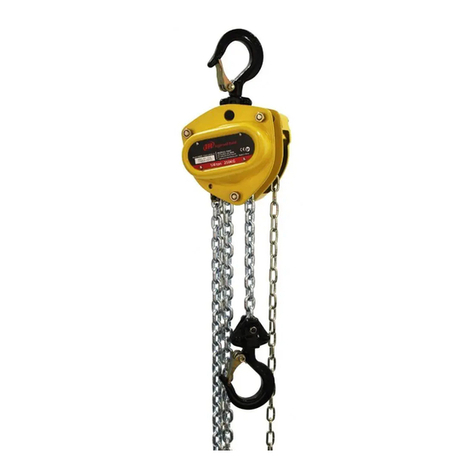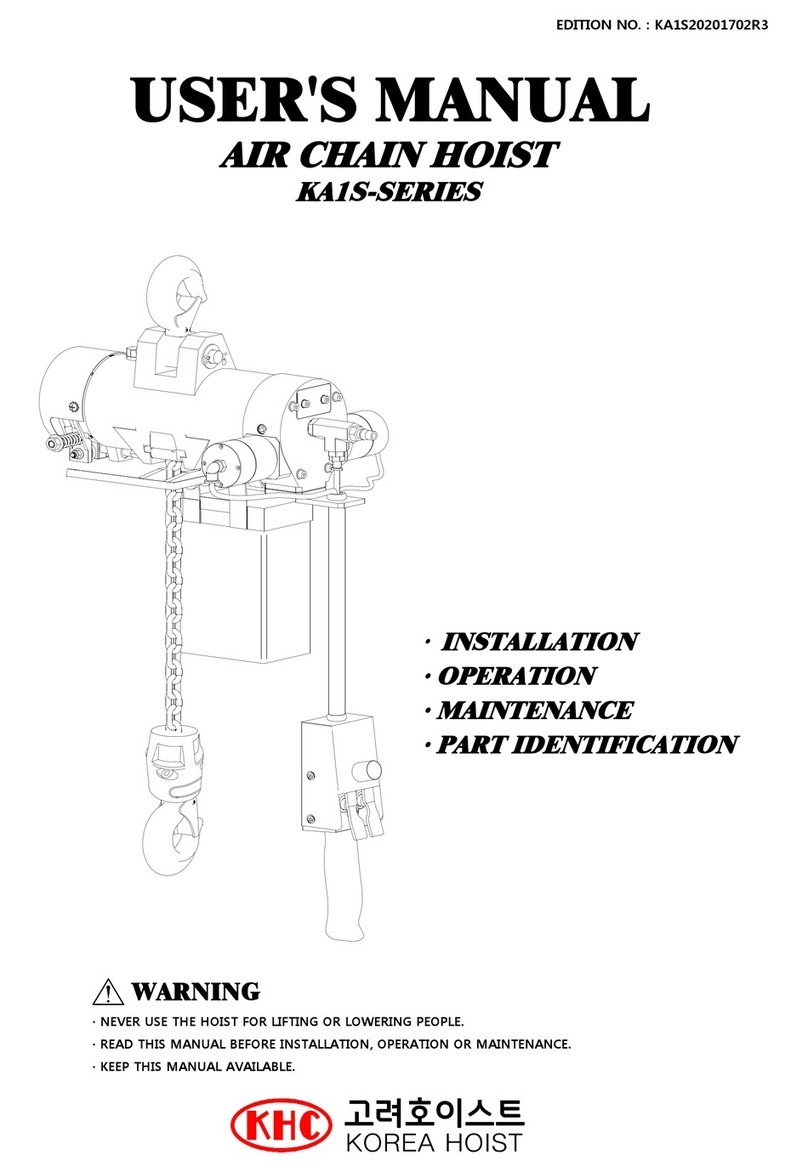SLG ET 200 N Guide

ET 200 N
1140807 (110V 50Hz)
HOIST
Operating,maintenance,spare parts manual
Contact Us
Tel: 0117 9381 600
Fax: 0117 9381 602
email: sales@safetyliftingear.com
Unit R1D Rockingham Gate
Poplar Way West
Cabot Park
Bristol
BS11 0YW

Dear customer,
Congratulations on purchasing a reliable and innovative
product created through years of experience.
-
WORKING IN SAFETY: The following instructions are
essential for safety.
This OPERATING AND MAINTENANCE manual must be kept
on site by the foreman and must be accessible for consultation
at all times.
The manual is be considered an integral part of the machine
and must be kept for future reference (EN ISO 12100-2) until the
machine is scrapped. If it is damaged or lost, a replacement copy
can be requested from the hoist manufacturer.
The manual contains important information on site preparation,
installation, operation, maintenance and ordering of spare parts.
The installer and operator must have adequate experience and
knowledge of the machine.
To guarantee complete safety of the operator, safe operation
and a long service life, follow the instructions in this manual
and observe current applicable legislation regarding safety and
accident prevention in the workplace (use of suitable footwear,
clothing, hard hats and safety harnesses, proper installation of
railings around drops, etc.).
-
It is strictly forbidden to modify the steel structure or
working parts of the machine in any way.
IMER INTERNATIONAL will accept no responsibility for failure to
comply with legislation and standards governing the use of hoisting
equipment, in particular: improper use, incorrect power supply,
inadequate maintenance, unauthorised modiÞcations, tampering
and/or damage and partial or complete failure to observe the
instructions contained in this manual.
-
IMER INTERNATIONAL reserves the right to modify
the characteristics of the hoist and/or the contents of this
manual without any obligation to update previous machines
or manuals.
1. GENERAL DESCRIPTION
-
Warning: Use of lifting equipment requires great skill
and care. The hoist must be used by skilled and properly
instructed personnel only.
-
1) The machine is designed exclusively for lifting
materials and for use on building sites.
-
2) The machine must not be used for lifting people
and/or animals.
-
3) The machine must not be used in potentially explo-
sive atmospheres or underground.
The machine consists essentially of (Þg. 1):
- Drum type winch Þtted to reduction gear shaft (3), wire rope (1),
lift hook (2) and counterweight (9).
- Gearmotor consisting of a self-braking electric motor (4) and an
oil-bath reduction gear unit (13).
- Electrical system (5).
- UP position control lever (8).
- Revolving frame (7) and a frame locking lever (10).
- 1 m pendant control with three pushbuttons (6).
2. IMER HOIST SUPPORT STRUCTURE
The structure on which the hoist is mounted must be able to
withstand the stresses generated during operation (Þg. 2).
The 400 N force is perpendicular to the 5000 N force. Since the
hoist is able to rotate on the supporting hinges, these forces must
be veriÞed in all possible positions of the hoist.
IMER offers a wide range of supports (see Þgures 7, 8, 9, 10, 11
and 12) for use on building sites, designed to suitably transfer the
stresses to the building structures.
-
IMPORTANT
The EC declaration of conformity enclosed with this manual is
valid only if components manufactured exclusively by IMER
are used (hoist and support structures).
If this condition is not satisfied, this declaration is valid only
for the hoist.
The installer should compile a new EC declaration of con-
formity, after verifying all requirements stated in the Machi-
nery Directive 2006/42/EC for the equipment and support
assembly.
The forces on the support couplings must be accounted for in
calculations for the supporting structures (scaffolding, balconies,
ceilings, etc.) made by a qualiÞed technician.
If the hoist is to be mounted on scaffolding, the latter must be
adequately braced against wind (see Þg. 13).
Follow the instructions provided for installation of the various
supports.
If supports with different capacities from the hoist are used, the
permissible capacity of the weakest element in the system must
be marked on the assembly in a clearly visible position.
2.1 PREPARING THE WORKPLACE
- The loading access area must be protected by a rail
at least 1 m high and with a foot stop.
- Make sure that the lifting run is free from obstacles and make
sure that no one can lean out from intermediate ßoors.
- Cordon off the ground loading area to ensure that no one enters
the area during lifting.
3. MOUNTING THE HOIST (fig. 1)
1) Only competent, trained personnel may assemble and operate
the hoist.
Given the weight of the hoist, it must be transported and installed
by an adequate number of operators to avoid hazardous situations.
2) The maximum working height (30 m) corresponds to the gear-
motor position, i.e. it is measured from the top hinge of the support.
3) Secure the support to the building and check the vertical ali-
gnment of the support pins (11), then lift the locking lever (10),
insert the frame bushings (7) onto the
pins and Þt the split pin retainer (12).
4) When mounting on a trestle support,
secure the frame (7) to the carriage
through the securing holes Fig.12) using
the screws and self-locking nuts. For the
rest of the installation procedure, follow
the instructions for the trestle support.
5) The pendant controls have three
pushbuttons (Þg. 3):
black = down
white = up
red = emergency stop
6) Release the hook.
4. CONNECTION TO THE ELECTRICITY MAINS
- Make sure that the mains voltage corresponds to the rating on
the machine’s rating plate.
- Also ensure that the mains voltage is within the range -5% to
+5% with the hoist operating at full load.
- The electrical supply line must be Þtted with both overcurrent and
differential type protection devices and the earth wire must have
the same cross-section as the live wire. The wires must be sized
taking into account the operating currents and the length of the
line to avoid excessive voltage drops (see Table 1).
Do not use extension leads wound onto drums.
- The power supply cable must be suitable for frequent handling
and must have an abrasion-resistant sleeve (e.g. H07RN-F).
- Connect the machine’s plug to a 16 Amp EEC socket with an
IP67 protection factor and tighten up the securing collar.
-The hoist is now ready for testing.
TRANSLATED INSTRUCTIONS
Fig. 3
Fig.2

5. TESTING
-Warning!! Testing must be carried out by qualified
personnel only. Take all necessary safety precautions.
-Warning: the hoist must be tested before use.
Before testing the hoist make sure that it has been correctly
installed.
1) Lower the unloaded rope to the lower loading position by pres-
sing the down button, and check that at the end of its travel three
turns of rope remain on the drum.
2)No-load test. Apply a small load (20 kg) and check that the
machine works correctly by running a complete up/down cycle.
Test the up, down and emergency stop buttons and check that
the up limit switch and the electric motor brake work correctly and
that the cable winds correctly onto the drum.
3)Load test. Load the hoist with the maximum allowable load.
Run a complete up/down cycle to test the stability of the supports
and the motor brake.
After the test, check the support structure for failure and slippage
and recheck the horizontal alignment of the drum (using a level
as shown in Þg. 1).
4) The hoist is Þtted with a safety device which stops travel at the
fully raised position (9).
It is however good practice to stop the hoist before the safety
device activates by releasing the UP button.
When the rope is completely unwound, the operator standing near
the machine must check that the rope does not wind in the wrong
direction onto the drum.
When testing is completed, Þll in the test report with the date,
installation check and signature (Table 2) along with any other
comments.
-The test procedure described above, complete with
no-load (2) and load (3) tests, must be performed every time
the machine is installed.
6. SAFETY WARNINGS AND OPERATING PRECAUTIONS
-
1) Never lift loads exceeding the capacity of the elevator.
-
2) Never allow persons to remain below suspended
loads.
-
3) Never try to lift loads anchored to the ground (e.g.
embedded posts, plinths, etch.).
-
4) Ensure that the load is securely connected to the
elevator hook and also close the safety catch (ref.6 fig. 4.1).
-
5) If the load requires accessories to be attached to be
hooked up, these must be certified and approved (harnesses,
ropes, slings, etc.). The weight of these accessories must be
subtracted from the maximum capacity.
-
6) Ensure that no part of the load protrudes during the
lifting phases.
-
7) Before releasing the load, ensure that it is in a stable
position.
-
8) A suspended load must never be detached to cause
sudden release or by cutting the slings, causing a backlash
movement of the entire structure.
-
9) Never move hands or parts of the body near the drum
during operation, as this constitutes a risk of entrapment in
the ropes unwinding, with the risk of serious accidents.
-
10) Never move hands or parts of the body near the
counterweight during the ascent phase, as this constitutes a
risk of crushing on contact with the limit switch lever.
-
11) Avoid use in adverse weather conditions (wind or
storms) as the load is not guided. Maximum wind speed must
not exceed 12.5 m/s.
-
12) The control position and lighting conditions must
ensure perfect visibility of the load throughout travel.
-
13) Ensure that all guards and safety devices are fitted.
-
14) During use, check that the rope unwinds correctly,
turn on turn, without slackening or twisting, which can cause
damage to the rope. If this occurs, unwind the rope and rewind
correctly keeping the rope tensioned at all times.
-
15) Ensure that the travel and work area is free of ob-
stacles throughout the height and take necessary precautions
to prevent persons from leaning out of intermediate floors.
-
16) Delimit the lower load area to prevent persons from
being present during lifting.
-
17) Keep children at a safe distance from the elevator.
-
18) When the elevator is not in use, do not allow unau-
thorised personnel access or operation.
-
19) Use of the elevator for oblique tractions is strictly
prohibited (over 5° with respect to vertical angle).
-
20) Never rotate the elevator on the pins by pulling the
pendant control; it must always be rotated manually from
the frame.
-
21) Do not leave a suspended load unattended. Raise
or lower it and unload it.
-
22) During lifting or lowering, never allow the load to
turn as this may cause the rope to break.
-
23) Before leaving the elevator unattended, remove the
load, wind the rope completely onto the drum, and detach the
power plug from the mains.
-
24) When a load is to be raised or lowered, this must
be done in such a way as to minimise dangerous sideways
and vertical movements.
-
25) Protect the winch against the rain.
When operation is resumed after an extended period of disuse
(e.g. overnight) the entire machine must be tested under no-load
conditions before starting (as described in section 5, point 2).
7. CHECKS AND MAINTENANCE
-
Warning! All maintenance work must be carried out
with the machine switched off, unloaded and disconnected
from the mains.
-Repairs must be made by qualiÞed personnel or by the IMER
technical service.
-Use only IMER original spares.
-
Check the motor brake every 6-7 days.
-
Make sure that the notices and inscriptions on the
machine remain legible.
-
Keep the machine clean of dirt.
-
Check operation of the UP limit switches at the start
of every work shift.
-
Check the electrical cable for accidental damage at the
start of every work shift.
7.1 WIRE ROPE
Use only new ropes, with a manufacturer's certiÞcate of conformity
attesting their satisfaction of the following speciÞcations and of
standard UNI EN 12385-4. These are minimum speciÞcations: ropes
with better speciÞcations may be used, with the exclusion of the OD,
which must always be 4 mm.
External diameter : 5 mm
Type : 133 wires anti-spin
Direction of lay : CDX
Strand dia.: 0.32 mm
Strand strength : 1960 N/mm2
Preformed: Yes
Minimum breaking strain : 16 kN
Length : 31 m
Surface treatment : galvanised and greased
The IMER reference code is given in the spare parts table.
7.1.1 ROPE REPLACEMENT
This operation must be carried out by an authorised IMER
International service centre.
Remove the hook (ref. 2, Þg. 1) and withdraw the cable weight.
The drum is equipped with a device to ensure that two turns
of rope remain fully wound on; when a new rope is Þtted, this
condition must be maintained.

1) Fully unwind the rope.
2)Withdraw the rope from the inside of the drum through the
hole and the slot.
3)Feed the new rope into the hole and out of the slot on the
side of the drum (Þg. 4.1).
4) Tighten the clamp at the end, leaving a free end
approximately 1 cm long, and pull the rope to bring the clamp
up against the internal wall of the drum.
Fig. 4.1
5)Wind on two complete turns, keeping the rope in contact with
the drum (Þg. 4.2).
6)Use a suitable cable clamp for the rope used (Þg. 4.3).
Fig. 4.2 Fig. 4.3
7)On third turn, feed the rope over the slot in the drum and
push it into the slot using the cable clamp (Þg. 4.4).
Fig. 4.4
Fig. 4.5
8)Insert the screw through the side of the drum and the cable
clamp and screw it into the threaded insert at the opposite end.
(Þg 4.5).
9)Pull on the rope to ensure contact around the entire
circumference of the cylinder.
10) Wind on the rope, laying turn on turn in consecutive layers.
11)Insert the rope in the counterweight and aluminium sleeve.
12)Insert the thimble in the hole of thehook.
13)Run the wire rope back through the sleeve and tighten the
thimble in the loop formed.
14)Pull the rope to tighten all the parts together. Then press the
aluminium sleeve with a suitable press or tool. (Þg. 4.6)
Fig. 4.6
15)Check that the ascent limit switch is triggered when the
counterweight hits the lever.
16)Carry out a test under load as described in paragraph 5,
and log the rope replacement operation in TAB. 2.
7.1.2 PERIODIC CHECKS
-Visually inspect the condition of the rope daily and
whenever it is subjected to abnormal strain (twisting, bending,
kinks or abrasion).
Replace the rope when defective (Fig. 14).
- Daily and before using the elevator control the proper
conterweight to the arrest of the top spot and must not be
stopped due to deformation of the wear of the lever of the
limit switch.
Every three months inspect the entire rope carefully and in parti-
cular the ends. Note down the results in the chart (Table 2) which
must be kept by the site foreman.
- Replace the rope at least once a year.
7.2 ADJUSTING THE MOTOR BRAKE (Fig. 5)
The electric motor brake is engaged in the event of power supply
failure to the motor.
In the event of reduced braking power, the hoist must be checked
by a skilled maintenance engineer, for adjustments if necessary.

-
CAUTION! Before working on the brake, ensure that
the load is removed, the electric power plug is disconnected
and the motor is cool.
Fig. 5
7.2.1. Braking adjustment
Remove cap 5 from fan cover 1.
Increased braking: turn locknut 6 gradually counter-clockwise and
check that the brake disengages in descent.
Decreased braking: turn locknut 6 clockwise.
7.2.2. Air gap adjustment
If the brake blocks or in the event of excessive wear, the air gap
should be adjusted as follows.
Remove fan cover 1 and disassemble fan 2.
Loosen the three hex screws 3.
Brake block: turn ringnut 4 clockwise to increase air gap 7 ad
release the brake, checking the gap distance (0.6-0.8 mm).
Brake wear: turn ringnut 4 counter-clockwise to reduce the air
gap, checking the gap distance (0.6-0.8 mm).
Tighten the three hex screws 3 fully down and reÞt the fan and
fan cover.
To check brake grip, after adjustment, test braking several times
under full load.
7.3 GEARMOTOR LUBRICATION
The gearmotor unit must not develop oil leaks. Leaks may indicate
damage to the aluminium casing. In this case, reseal or replace
the casing.
-
Check the gearmotor oil level through the sight glass
before every start-up. Refill as required. The oil should be
changed approximately every 2000 hours. Use gear oil with
ISO VG 460 viscosity at 40°C
(SAE 90-140)
.
-
Spent oil is classed as special waste and must be di-
sposed of in accordance with current applicable legislation.
7.4 ELECTRICAL SYSTEM
Check the condition of the insulating pendant control case. If it is
damaged replace it with an original IMER spare. Make sure that
the steel cable connecting the pendant control to the electrical
panel is shorter than the electrical cable to protect against pulling.
8. DISMANTLING THE HOIST
Remove all loads from the hook.
Wind the wire rope completely onto the drum. Disconnect the
power plug.
Remove the split pin from the support hinge and remove the
rotating frame.
If a trestle is being used, the carriage must be removed from
the hoist after it has been taken off the guides and before the
counterweight is removed.
9. TRANSPORT AND STORAGE
-Do not leave the installed hoist unattended without Þrst discon-
necting the electric power supply and winding the rope completely
onto the drum.
When the machine is to be stored for a long period of time, make
sure that it is protected against atmospheric agents.
-During transport protect the machine from shock and crushing
which can adversely affect its functionality and mechanical
strength.
10. SCRAPPING THE HOIST
To scrap the machine at the end of its service life, carry out the
following steps:
a)Drain out the oil by removing the oil plug.
b) Separate the various plastic and electrical components (cables,
pendant control, etc.).
c) Divide up the metal components according to the type of metal
(steel, aluminium, etc.).
After the various components have been separated, dispose of
them through authorised disposal centres.
-
Dispose of properly. These components can cause
accidents and pollution.
11. TROUBLESHOOTING
FAULT CAUSE SOLUTION
Difficult to
lengthen the
telescopic arm
Emergency stop
button engaged Turn to disengage
No power to
machine
Check mains
cable
Plug not inserted Insert the plug
Power board
cutout tripped
Reset the overlo-
ad trip
Difficult to
lengthen the
telescopic arm
Lock knob too
tight Slacken
The machines
lowers but does
not lift
Up limit switch is
faulty Repair
IF THE FAULT PERSISTS Contact IMER
technical service
12. PROCEDURE IN EVENT OF FAULT WITH LOAD
SUSPENDED
- If possible remove the load from the nearest level, then dismantle
and service the hoist.
- If this is not possible, use another lifting machine (with adequate
lifting capacity) from higher up and suspend the faulty hoist both
at the load and at the hoist attachment point.
Lift the faulty hoist slowly off its Þtting, then lower the entire as-
sembly to the ground.
-Do not attempt to turn the brake adjustment nut, as it would
become uncontrollable.
-Do not attempt to repair the fault on the machine with the load
suspended.
13. NOISE LEVEL AT THE OPERATOR’S EAR
The level Lp(A) given in the TECHNICAL DATA chart corresponds
to the weighted equivalent sound pressure level on scale A of Eu-
ropean Directive 2006/42/EC. This level is measured with no load,
at the operator’s head in the working position 1.5 metres away
from the instrument, considering the different working conditions.

12
Fig.6
SCHEMA ELECTRICO - WIRING DIAGRAM -
TAB.1
I
GB
Lunghezza cavo (m)
Cable length (m) 0 ÷ 12 13 ÷ 20 21 ÷ 32
I
GB
Sezione cavo (mm²)
Section câble (mm²) 3x 2.5 4 6
PE CONDUTTORE DI PRO-
TEZIONE PROTECTION WIRE
NCONDUTTORE NEUTRO NEUTRAL WIRE
L1 CONDUTTORE DI LINEA PHASE WIRE
S1 PULSANTE ARRESTO STOP BUTTON
S2 PULSANTE SALITA UPSTROKE BUTTON
S3 PULSANTE DISCESA DOWNSTROKE BUTTON
FS FINECORSA SALITA UPSTROKE LIMIT SWITCH
X1 CONNETTORE MOTORE MOTOR CONNECTOR
CCONDENSATORE CAPACITOR
C1 CONDENSATORE CAPACITOR
AS AVVOLGIMENTO MOTO-
RE SALITA
MOTOR WINDING,
UPSTROKE
AD AVVOLGIMENTO MOTO-
RE DISCESA
MOTOR WINDING, DOWN-
STROKE

PUNTELLO PER INTERNI
HOIST FRAME FOR INTERMEDIARY FLOORS
ELEVATORE
HOIST
TRAVE
BEAM
PARAPETTO
PARAPET
TRAVE
BEAM
LIVELLA
SPIRIT LEVEL ZONA LAVORO OPERATORE
OPERATOR WORK ZONE
POSIZIONE APPOGGIO SUPERIORE
POSITIONING TOP FOOT
KIT PER PUNTELLO DA ESTERNI
HOIST FRAME FOR ROOFS
LIVELLA
SPIRIT LEVEL
CONTENITORE ZAVORRA
COUNTER WEIGHT
CONTENITORE ZAVORRA
COUNTER WEIGHT
CONTENITORE ZAVORRA
COUNTER WEIGHT
ZONA LAVORO OPERATORE
OPERATOR WORK ZONE
ELEVATORE
HOIST
PARAPETTO
PARAPET
POSIZIONE DI LAVORO
WORK POSITION
PARAPETTO
PARAPET
ATTACCO A PONTEGGIO
HOIST FRAME FOR SCAFFOLDING
ELEVATORE
HOIST
ZONA LAVORO OPERATORE
OPERATOR WORK ZONE
POSIZIONE DI LAVORO
WORK POSITION
Fig. 7
Fig. 8
Fig. 9
- PROLUNGA PER PUNTELLO
- JIB EXTENSION FOR INTERMEDIARY FLOOR
AND ROOF FRAMES
Fig. 10
cod. 1199102
cod. 1199134
cod. 1199170
cod. 1199150
140Kg
200Kg
200Kg
320Kg

-I valori delle sollecitazioni sugli ap-
poggi tengono conto di un coefficiente
di sovraccarico statico di 1,25.
- The forces on the links are evaluated
considering a overload coefficient of
1,25.
Fig. 12.1
SI!
YES!
NO!
ELEVATORE
HOIST
ZONA LAVORO OPERATORE
OPERATOR WORK ZONE
FINESTRA
WINDOW
POSIZIONE DI LAVORO
WORKING POSITION
PUNTELLO A FINESTRA
HOIST FRAME FOR WINDOWS Fig. 11
cod. 1199105
CAVALLETTO (PORTATA MAX 200kg)
GANTRY HOIST (MAX CAPACITY 200kg)
LONGARINA
RUNWAY
Fig. 12
cod. 1191230
cod. 1199210
CONTENITORE ZAVORRA
COUNTER WEIGHT
ZAVORRA = 2X100 kg
COUNTER
cod. 1199230
CARRELLO PER ELEVATORE-
TRAVEL CARRIAGE
cod. 1191041
NO! SI!
YES!
Fig. 13
STRUTTURA DI SUPPORTO A CAVALLETTO IMER (PORTATA MAX 200 kg)
IMER GANTRY HOIST ( MAX CAPACITY 200 kg)

Fig. 14
RICAMBI: Per tutti gli ordini dei pezzi di ricambio vogliate indicare: 1 - Tipo di macchina. 2 - Numero di codice e di riferimento collocato in
corrispondenza di ogni deÞnizione. 3 - Numero di serie e anno di costruzione riportato sulla targhetta della macchina.
SPARE PARTS: All orders for spare parts must indicate the following: 1 - Type of machine.2 - Part number and position number of each
part.3 - Serial number and year of manufacture reported on the machine's identiÞcation plate.
PUNTI DI VISIBILE APPIATTIMENTO
VISIBLE FLATTENED POINTS
CORROSIONE INTERNA O ESTERNA
INTERNAL OR EXTERNAL CORROSION
ROTTURA DI UN TREFOLO
BREAKING OF ONE STRAND
ROTTURA DI SINGOLI FILI
BREAKING OF SINGLE WIRES
FORMAZIOME DI ANSE
LOOPS

TAV. 1 I GB ES 150 N
1140908
RIF. COD. ELEVATORE HOIST NOTE
1 3204404 TELAIO FRAME
2 2201725 ALBERO TAMBURO DRUM SHAFT
3 2204550 CUSCINETTO BEARING 6205
4 2203155 SUPPORTO TAM-
BURO DRUM SUPPORT
5 3235880 TAMBURO DRUM
6 3224742 LEVA FINECORSA LIMIT LEVER
7 2214510 CONTRAPPESO CABLE WEIGHT
10 3233148 FUNE ACCIAIO +
GANCIO WIRE ROPE + HOOH
12 2229400 LINGUETTA KEY 8X7X30
13 2207355 ANELLO PARAOLIO OIL SEAL RING 52X25X7
15 2237299 DISTANZIALE SPACER
16 2202499 INGRANAGGIO GEAR Z.76
17 2227280 ANELLO ARRESTO CIRCLIP E/25
18 2229450 LINGUETTA KEY 8X7X20
19 2235420 LIVELLO OLIO OIL LEVEL PLUG
20 3213528 INGRANAGGIO GEAR Z.76
21 2202497 INGRANAGGIO GEAR Z.26
22 2201130 ALBERO PIGNONE PINION SHAFT
23 2229327 LINGUETTA KEY 6X6X40
24 2204440 CUSCINETTO BEARING 6004
25 3225254 FLANGIA RIDUTTORE INNER CASE HALF
26 3225294 CARCASSA RIDUT-
TORE
REDUCTION GEAR
CASING
28 2204391 CUSCINETTO BEARING 6205 2Z
30 3231720 MOTORE ELECTRIC MOTOR
31 2228820 SPINOTTO GUDGEON PIN Ø 6X14
32 2222509 VITE SCREW M8X20
33 2222513 VITE SCREW M8X30
34 2222514 VITE SCREW M8X40
35 2222099 VITE SCREW M10X40
37 2224355 ROSETTA ELASTICA SPRING WASHER Ø 10
39 2223650 DADO NUT M10
43 2222461 VITE SCREW M4X15
45 3231796 TARGA ELEVATORE RATING PLATE
46 3231738 PULSANTIERA CONTROL BOARD
47 3203739 SPINA A PARETE PLUG V110
48 3213061 CONDENSATORE CAPACITOR ȂF 140
49 3231736 CASSETTA ELET-
TRICA JUNCTION BOX
51 3200005 FINECORSA UP LIMIT SWITCH
53 2223920 DADO AUTOBLOC-
CANTE SELF LOCKING NUT M.10
57 3225019 VENTOLA MOTORE MOTOR FAN
58 3225020 COPRIVENTOLA FAN COVER
62 3224575 COPERCHIO COVER
63 3225012 CEPPO FRENO BLOCK FOR BRAKE
70 3224714 GUARNIZIONE GASKET
71 2216331 GUARNIZIONE GASKET
72 2227700 ANELLO ARRESTO CIRCLIP I/52
74 3233149 SPINA GUDGEON PIN Ø 5X40
75 2216321 GUARNIZIONE GASKET
76 2237301 DISTANZIALE SPACER
81 2222018 VITE SCREW M8X35
82 2224140 ROSETTA WASHER Ø 8X18
83 2224350 ROSETTA ELASTICA SPRING WASHER Ø 8
84 2223570 DADO NUT M8
86 2224340 ROSETTA WASHER Ø10X20
90 2222008 VITE SCREW M12X70
91 2231410 MOLLA SPRING
92 2223921 DADO AUTOBLOC-
CANTE SELF LOCKING NUT M12
95 2259990 LEVA DI BLOCCAG-
GIO FRAME LOCK LEVER
97 3225319 MOLLA SPRING
98 3229797 CONDENSATORE CAPACITOR MF 100

63
Contact Us
Tel: 0117 9381 600
Fax: 0117 9381 602
email: sales@safetyliftingear.com
Unit R1D Rockingham Gate
Poplar Way West
Cabot Park
Bristol
BS11 0YW
Table of contents
Popular Chain Hoist manuals by other brands
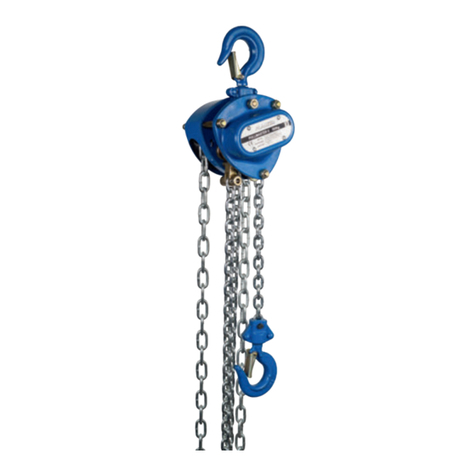
Planeta
Planeta Pullmaster-II Operating and maintenance instructions
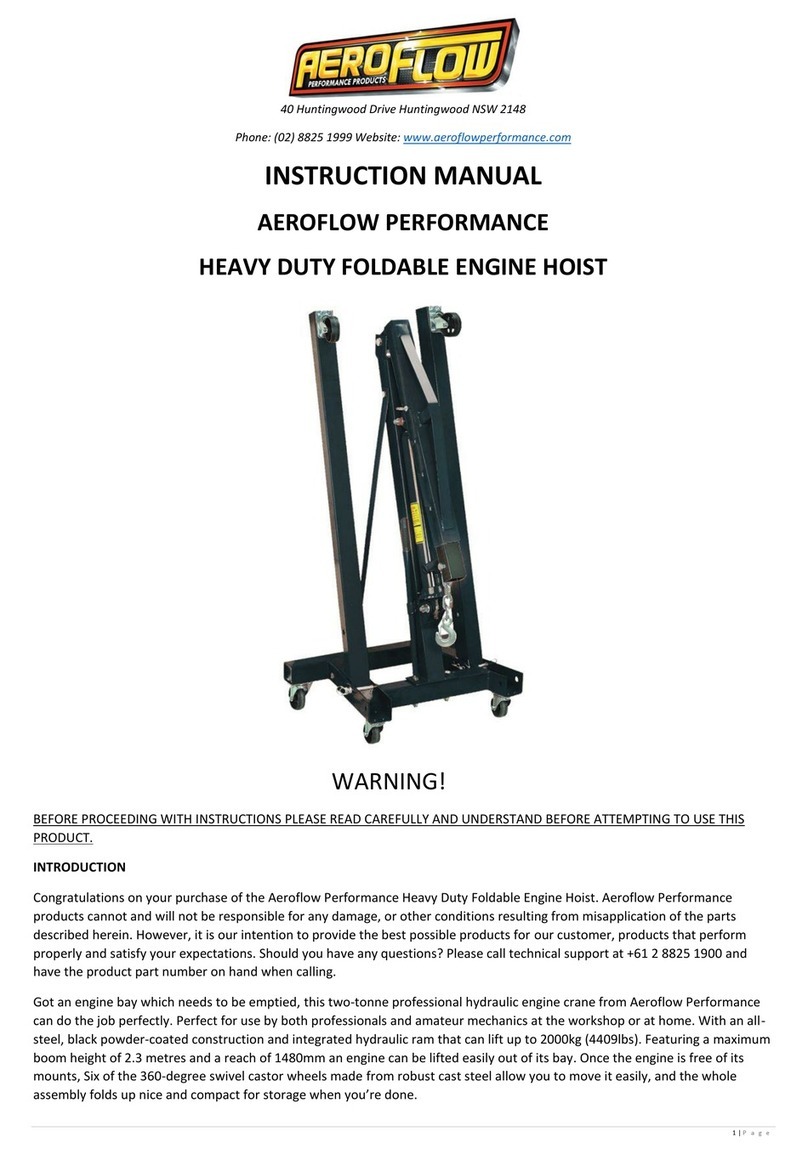
AeroFlow
AeroFlow PERFORMANCE instruction manual
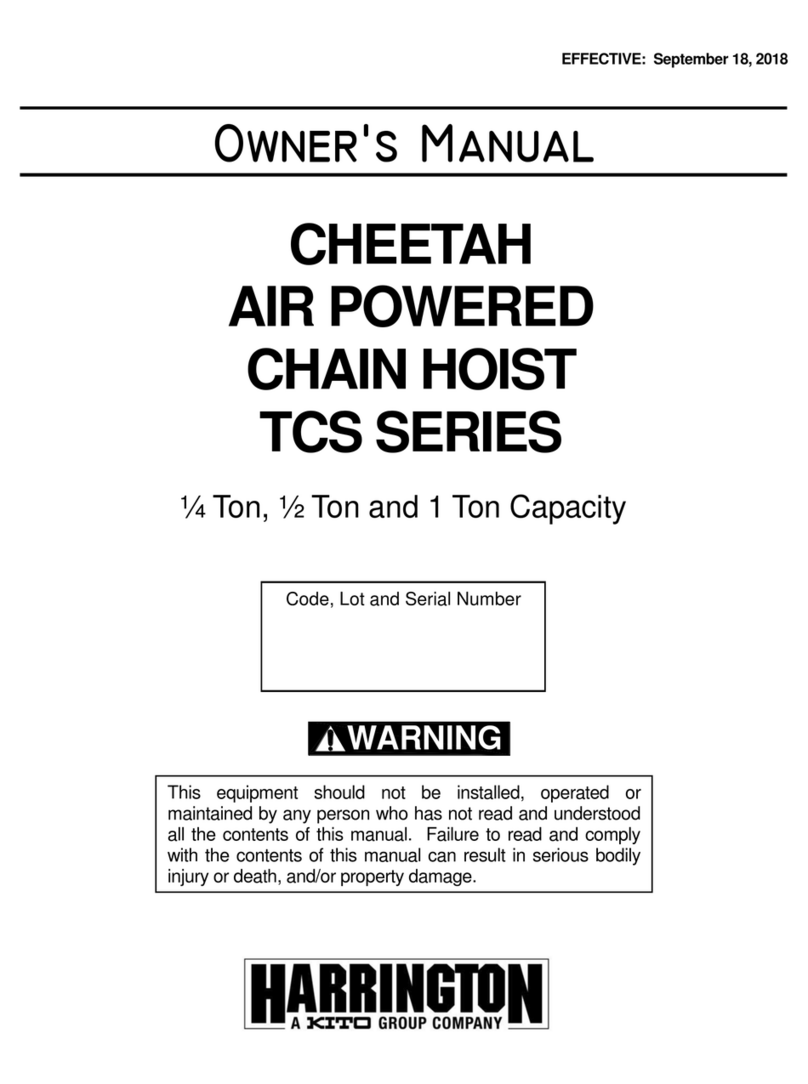
Harrington
Harrington TCS Series owner's manual

Tractel
Tractel Bravo AC Operation and maintenance manual

Tractel
Tractel corso 0,25 t Operation and maintenance manual

little mule
little mule LMSC Series Operating, Maintenance & Parts Manual
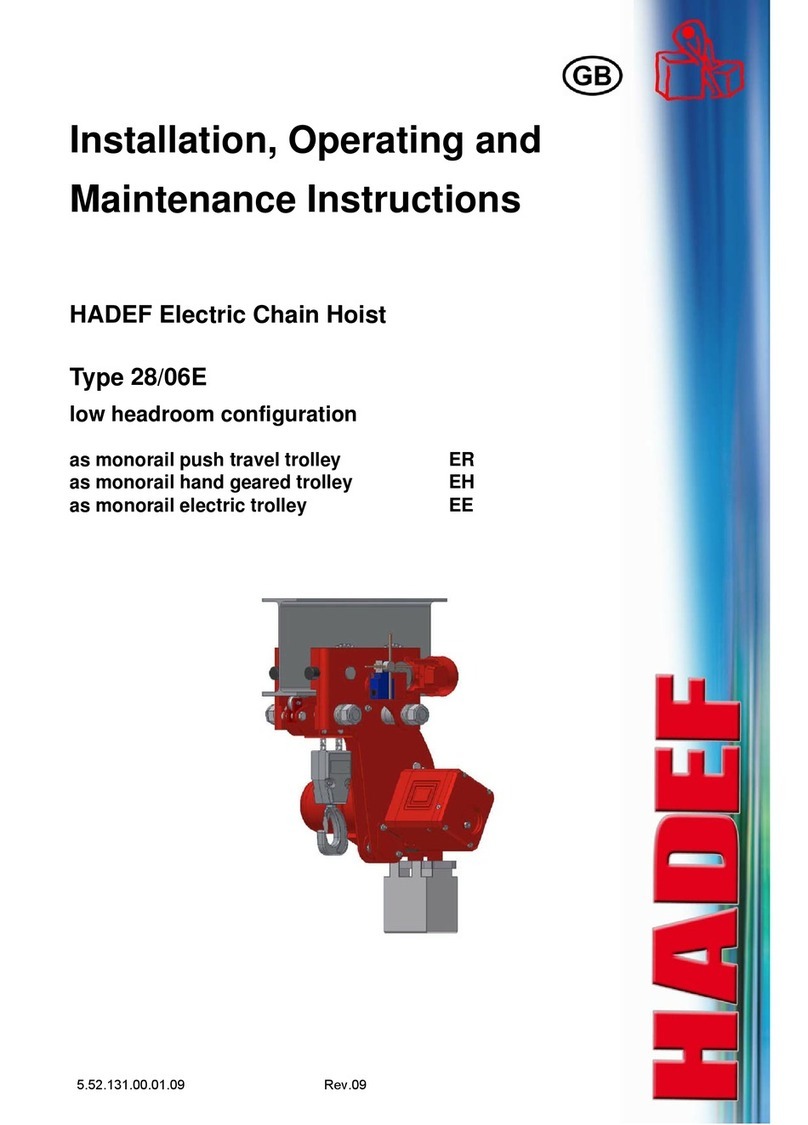
HADEF
HADEF 28/06E Installation, operating and maintenance instructions

POWERTEX
POWERTEX PCB-S1 Instructions for use
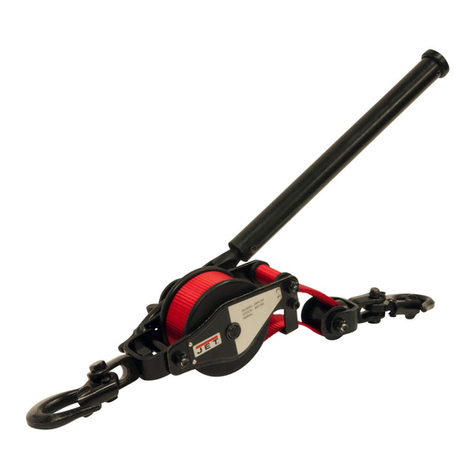
Jet
Jet JWS Series Operating instructions and parts manual
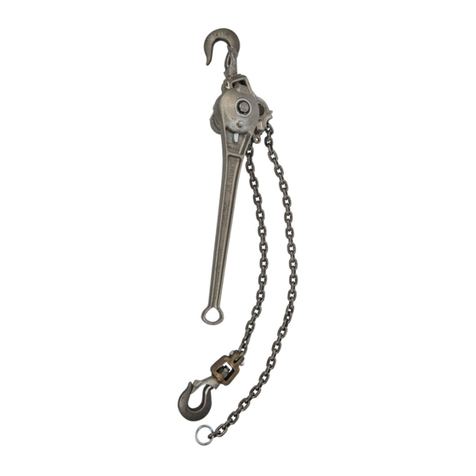
Hubbell
Hubbell 4012 operating instructions

Tractel
Tractel bravo Series Operating and maintenance instruction
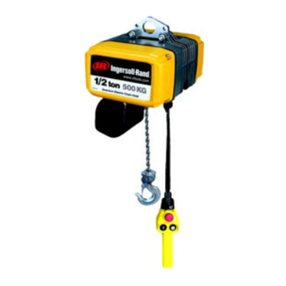
Ingersoll-Rand
Ingersoll-Rand Quantum QCH Series Product information
